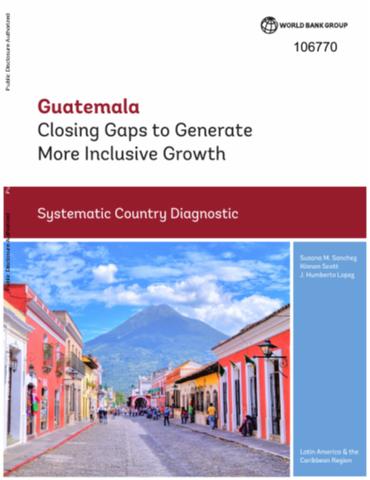Resource information
This Systematic Country Diagnostic (SCD) looks at why a country with such great potential has not been able to materialize it. The SCD analysis has identified several knowledge gaps. The analysis in this report focuses on the 2000 to 2014 period, covering the boom years before 2008 and the global financial crisis and recovery years up to 2014. It is based on a rich household data set from the National Living Standards Measurement Survey (ENCOVI) as well as on data on malnutrition from the 2014 National Survey of Maternal and Child Indicators (ENSMI). Where relevant and where there are available data, longer times series have been constructed, but the focus of the report is on this 15-year period. The analysis has some limitations. The SCD team identified various countries that could be considered to be Guatemala’s peer and aspirational countries in terms of their income level and population size, and whenever it is relevant to do so, the report benchmarks Guatemala’s performance against the performance of those countries. The report is organized as follows: After the overview presented here in Chapter 1, Chapter 2 provides evidence of the trends in poverty, shared prosperity, and inequality in Guatemala. The first section benchmarks Guatemala’s progress in reducing income poverty against its peer countries. This is followed by an examination of consumption poverty, which is the official measure of poverty used in Guatemala. The analysis highlights the gaps between the two Guatemalas. The chapter ends with some findings concerning the drivers of poverty, specifically focusing on the roles played by prices, labor, and transfers. Chapter 3 attempts to answer the question of how inclusive economic growth has been in Guatemala, looking first at the limited role played by labor markets in helping people to rise out of poverty and at the limited human capital and the dearth of opportunities to increase it. The chapter then discusses the ineffective and inadequate public spending that rives these outcomes and demonstrates the link between limited opportunities and poor outcomes, focusing specifically on malnutrition and vulnerability. Chapter 4 analyzes the drivers of growth and the roles and characteristics of key sectors. Important changes in trade policies are then covered, and the chapter ends with a detailed discussion of the main constraints to increasing investment and productivity and to creating high-quality jobs. Chapter 5 focuses on various fiscal, environmental, and social challenges. Major concerns about tax revenues, water resources and land use are highlighted. The final chapter summarizes the priorities that have emerged from the analysis and describes a set of policies or areas of action that have the potential to put Guatemala on a path of higher and more inclusive growth.


